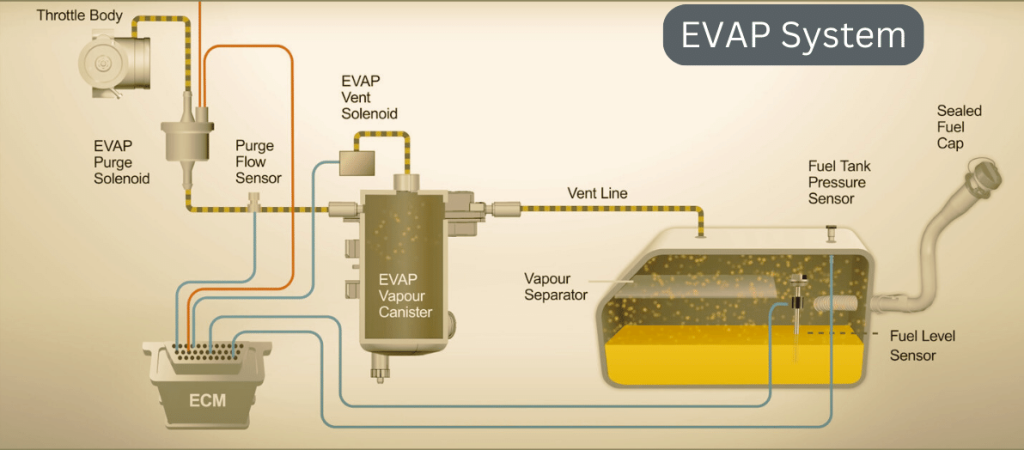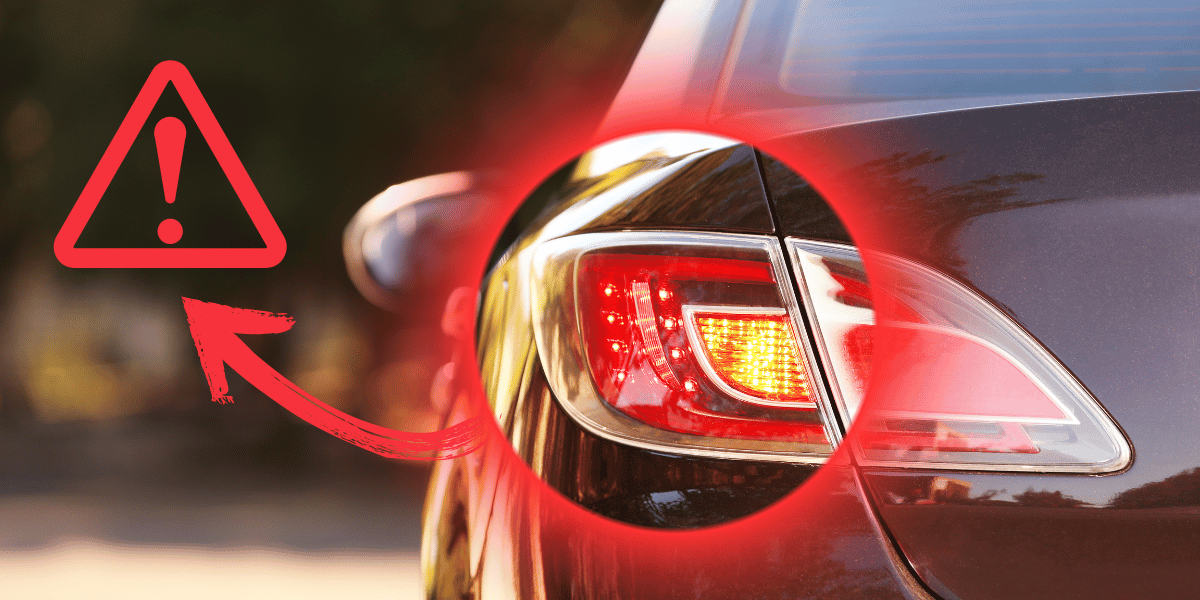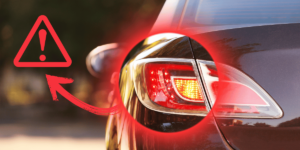Welcome to the world of automotive magic, where the smallest parts can make a huge difference. The canister purge valve is the piece of the puzzle we’ll be looking at today. You might be wondering, “What’s the deal with this small, easy-to-miss part?” Now that we’ve cleared up some questions about the canister purge valve, let’s talk about why it’s so important to your car’s emission control system.
The Canister Purge Valve: A Vital Emission Control Player
Feel the wind in your hair (or at least through the window) as you drive down the highway on a trip. Your car is a modern wonder. It has a complicated system that cuts down on pollution and keeps the air clean. The canister purge valve comes on stage at that point.
This small valve looks like nothing, but it has a big job: it controls the petrol vapours that your car makes. You know, those smells that can make your nose tickle at the petrol station? The canister purge valve keeps those vapours from escaping into the air. It’s the hidden hero.
Why Should You Care About the Canister Purge Valve?
“Why should I give a hoot about this valve?” you may be asking. Yes, dear reader, there is more to it than meets the eye. The canister purge valve might not be the most exciting thing in the world, but it is very important to the health and efficiency of your car.
Please fasten your seatbelts, dear readers, because we are about to start on a journey through the world of the canister purge valve. This journey will combine our knowledge of automotive technology, our concern for the environment, and our desire to drive in a cleaner, greener way.
What Is the Canister Purge Valve and How Does It Work?
The canister purge valve is a small but important part of your car’s engine that does a lot of different things. Today, we’re going to take the lid off of this important part and show you how it works in the evaporative emission control system (EVAP).
1. Role in Reducing Harmful Emissions
First, what’s the point of the cylinder purge valve? Imagine the petrol tank in your car as a prize chest full of fuel. Heat and motion from the car can cause this valuable cargo to give off vapours as you drive. Without the purge valve on the canister, these vapours would leak into the air, polluting it and wasting fuel. Here comes our hero: the purge valve on the cylinder.
2. How It Works?
So, how does the purge valve on the tank fight emissions? The main job of this part is to control the flow of petrol vapours from the fuel tank. As long as your engine is going and the conditions are right, the gate opens, letting these vapours enter the engine’s intake manifold. You can mix them with the air that comes in and burn them, leaving behind only safe by-products.
3. Working with Other EVAP System Components
But now is the time to work together. The purge opening on the canister doesn’t work by itself. Along with the EVAP canister, the EVAP vent solenoid, and other parts, it forms a dynamic group. They work together to make sure that petrol vapours are collected, kept, and then let out at the right time to be burned.
4. Effects on the Environment: What Happens When a Valve Breaks
The bad part of the story is now time to talk about what happens when the canister purge valve goes crazy. If a valve doesn’t work right, unburned fuel vapours can release themselves straight into the air. Not only does this hurt the environment by making the air dirty, but it also burns fuel, which can be expensive.
There you have it: the canister purge valve, a small but powerful environmental guardian. It’s an important part of the fight against harmful pollution and makes sure that your car runs better, cleaner, and greener. We will go into even more detail about how it works, how to tell when it’s acting up, and what you can do to keep it in great shape in the parts that follow. For more automotive education, stay tuned!
Symptoms of a Faulty Canister Purge Valve
Your car might not be able to talk, but it can sure let you know when something is wrong. When something is wrong with the canister purge valve, it can show some clear signs. We’ll talk about these symptoms and what they mean for your car’s performance and the environment in this part.
Common Red Flags
- Strong Fuel Smell: A strong petrol smell is one of the most obvious signs of a broken canister purge valve, especially when you’re at the petrol station. If you start to wrinkle your nose at the pump, it might mean that something is wrong.
- Trouble Starting the Engine: If your canister flush valve isn’t working right, your car might not want to start. If your engine cranks a lot without the key, it might be time to look into it.
- Less efficient use of gas: All of a sudden, your gas usage is dropping, and you’re stopping at the pump more often than you’d like. A bad flush valve can mess up how well your fuel works, which can cause you to use more fuel.
- Check engine light on: If the check engine light comes on, it could be because of a broken canister purge valve. Basically, the engine control unit (ECU) controls the valve. If the valve isn’t working right, the ECU may set a trouble code.
How These Symptoms Affect Vehicle Performance and Environmental Impact?
How these symptoms affect how well the car runs and how it affects the environment
If the canister purge valve isn’t working right, it can hurt the performance of the car and the environment.
- Strong smell of fuel: A strong smell of fuel can be unpleasant and make the driver and guests feel bad. In addition, it can be dangerous because it can make it hard to smell other things, like smoke or gas.
- Having trouble starting the engine: Having trouble starting the engine can be annoying and stressful. It can also cause people to be late or miss their meetings.
- Less fuel efficiency: Less fuel efficiency can save users money at the petrol station, but it can also make the car more harmful to the environment.
- Turning on the check engine light: A check engine light can mean that there is a major problem with the car. When the check engine light comes on, it’s important to have a skilled mechanic look at the car and fix it.
How important it is to quickly diagnose and deal with these problems?
It’s important to quickly figure out what’s wrong with a canister purge valve and fix it. A broken purge valve can make the engine use more gas, put out more pollution, and be hard to start. It may also make the check engine light come on.
It is important to have a skilled mechanic look at your car if you think the canister purge valve might be broken. The mechanic will be able to check the purge valve and other parts of the EVAP system to figure out what’s wrong. Once the expert knows what’s wrong, he or she can fix it or replace the broken parts. Most of the time, fixing or replacing a broken canister purge valve is a simple and cheap fix.
How to Test and Replace a Canister Purge Valve?
Testing the Canister Purge Valve with a Multimeter
Here’s how to use a Multimeter to test the canister purge valve:
- To find the resistance, set the voltmeter.
- Take the electrical link off of the purge valve on the canister.
- On each end of the canister purge valve, put one probe of the voltmeter.
- The voltmeter should show a resistance of 20 to 50 ohms if the purge valve is working right.
- If the resistance is outside of this range, the purge valve is faulty and needs to be replaced.
Changing out a broken canister purge valve
Simply follow these steps to safely change a broken canister purge valve:
- Put the car down on a flat surface and turn off the engine.
- Open the hood and look for the purge button on the canister. It’s normally close to the EVAP canister.
- Take the electrical link off of the purge valve on the canister.
- Loosen the bolts that hold the purge valve to the EVAP tank with a wrench.
- Take the EVAP canister’s vent valve off.
- Put in the new vent valve backwards.
- Put the power plug back on the purge valve.
- Close the hood and start the engine.
- Look for leaks or sounds that don’t sound right.
Important Things to Think About and Tips for Different Types of Vehicles
Depending on the make and type of the car, the steps needed to replace a canister purge valve may be different. For specific directions, it’s important to look at the owner’s manual for the car. Follow these general steps to change a canister purge valve:
- Make sure you get the right new part for your car. The owner’s instructions for the car or calling a dealer will help you find the right replacement part number.
- Be careful not to tighten the bolts that connect the EVAP cylinder to the purge valve too much. If the bolts are too tight, they can damage the valve.
- Once the purge valve is back in place, listen for any leaks or strange noises. Take the car to a skilled mechanic right away if you notice any leaks or strange noises. They will be able to figure out what’s wrong and fix it.
Importance of Following the Manufacturer’s Instructions and Using the Correct Tools and Replacement Parts
To properly replace a canister purge valve, it is important to stick to the steps given by the maker and make sure you have the right tools and parts. If you don’t do this, you could damage the car or hurt yourself. Here are some tips on how to use the right tools and new parts and follow the manufacturer’s instructions:
- Before you replace the canister purge valve, make sure you carefully read the owner’s manual for your car. The owner’s manual for your car will have specific directions on how to change the purge valve.
- To take off and put back on the purge valve, you need to use the right tools. If you use the wrong tools, you could damage the valve or other parts of the engine.
- Make sure you use the right new part for your car. The owner’s instructions for the car or calling a dealer will help you find the right replacement part number.
In conclusion: A canister purge valve replacement is a pretty simple fix that most people can do on their own. But it’s important to follow the instructions from the maker and use the right tools and replacement parts to keep yourself and the car from getting damaged.
The Role of Other EVAP System Components and its Parts
One of the most important parts of the EVAP system is the canister purge valve, but it can’t work properly without the other parts. There are many different parts that make up the EVAP system, which is a complicated system.
It’s time to take a look at the EVAP canister, EVAP vent solenoid, and fuel tank vent valve. You should now understand how the canister purge valve helps control emissions. Together with the purge valve, these parts make sure that your car runs cleanly and quickly.

1. The EVAP canister is the unit that stores emissions.
You can think of the EVAP canister as a place to store gasoline vapors. This part’s job is to catch the smelly gas that comes out of the tank when the car is not moving. It’s kind of like how a sponge soaks up spills, but this one is for gasoline vapors. These gases are then let out and burned in the engine, which keeps them from going into the air.
2. The EVAP Vent Solenoid is the part that keeps vapors out.
Now, picture the EVAP vent valve as the guardian who decides when and how the vapors are released. For combustion, the vent solenoid opens the gate when the engine is going and all the conditions are right. To cut down on emissions, it’s all about exact timing and control.
3. The Fuel Tank Vent Valve: Keeping Things Balanced
Last but not least is the fuel tank exit valve, which lets air into the fuel tank to replace the gasoline that is burned. If you don’t have this valve, the fuel tank could get dry, which would stop fuel from getting to the engine. So, it’s an important part of keeping the fuel system pressure right.
How the EVAP System Components Work Together to Control Emissions?
These parts, along with the canister vent valve, work together to control the EVAP system in your car. They take in, store, release, and burn gasoline fumes, which lessens the damage they do to the environment. It works like a well-tuned choir to make sure that your car not only runs smoothly but also in an eco-friendly way.
Why keeping all EVAP system parts in good condition is important?
It is important to keep all of the parts of the EVAP system in good shape to make sure the system works right. Incorrectly functioning EVAP system parts can cause more pollution, less fuel economy, and trouble starting the engine. Here are some ways to keep the parts of the EVAP system in good shape:
- A trained mechanic should check and service the EVAP system on a regular basis.
- Quickly replace any broken parts of the EVAP device.
- Do not put too much gas in the tank.
- Make sure the fuel cap fits the car correctly.
If you follow these tips, you can help make sure that your EVAP system is working right and lowering pollution.
What are the common error codes for EVAP emissions?
Here are some common EVAP system trouble codes (DTCs) and their meanings:
- P0440: Evaporative Emission Control System Malfunction
- P0441: Evaporative Emission Control System Purge Control Valve Circuit Malfunction
- P0442: Evaporative Emission Control System Leak Detected (Small Leak)
- P0443: Evaporative Emission Control System Purge Control Valve Circuit Malfunction
- P0445: Evaporative Emission Control System Purge Control Valve Circuit Malfunction
- P0446: Evaporative Emission Control System Vent Control Valve Circuit Malfunction
- P0452: Evaporative Emission Control System Pressure Sensor Circuit Malfunction
- P0455: Evaporative Emission Control System Leak Detected (Large Leak)
EVAP System DTCs and What They Mean?
DTCs in an EVAP system can mean a number of issues, such as
- Bad purge valve on the canister.
- A broken EVAP air solenoid.
- Bad fuel tank vent valve.
- Fuel tank cap that leaks.
- EVAP canister tubes or lines that leak.
- Problematic EVAP tank.
Why trouble codes are important?
These numbers are like dashboard lights in your car; they let you know when there might be a problem with the EVAP system. Ignoring them could mean more than just a bothersome light on your dashboard. It could cause more pollution, less fuel economy, and even problems with how well your engine works.
Getting help from a professional
Even though DTCs can be helpful, they don’t always tell you exactly what’s wrong. EVAP system problems can be hard to figure out and fix, and you should usually get help from a skilled mechanic. If you try to fix these problems without the right information and tools, you could make mistakes that cost a lot of money. So, don’t be afraid to talk to a professional when those trouble codes show up.
How to Take Care of and Maintain the EVAP System?
Here are some ways to make sure the EVAP system stays in good shape:
- Do not put too much gas in the tank. If you fill up the fuel tank too much, fuel vapors can leak into the EVAP system and damage the parts inside.
- A trained mechanic should check and service the EVAP system on a regular basis. A skilled tech will be able to find any issues with the EVAP system and fix them before they get worse.
- Quickly replace any broken parts of the EVAP device. Incorrectly functioning EVAP system parts can cause more pollution, less fuel economy, and trouble starting the engine.
Why regular inspections and maintenance are important for protecting the environment and lowering emissions?
For protecting the climate and lowering emissions, it’s important to check and maintain the EVAP system on a regular basis. If the EVAP system isn’t working right, fuel vapors can leak into the air, which can pollute the air and cause smog. If you follow the tips above, you can help make sure that your EVAP system is working right and lowering pollution.
Can I clean a canister purge valve?
How to Clean the Canister Purge Valve on Your Own? Here’s an easy way to clean the canister purge valve on your own:
- Take the electrical link off of the purge valve on the canister.
- Take the canister purge valve off of the car.
- Using a carburettor cleaner, spray the canister purge valve.
- Clear out the canister vent valve of any dirt or dust with a wire brush.
- Clean the canister flush valve by running water over it.
- Let the purge valve on the canister dry out fully.
- Put the canister vent valve back in the car.
- Connect the electricity plug back to the purge valve on the canister.
In conclusion: For protecting the climate and lowering emissions, it’s important to check and maintain the EVAP system on a regular basis. If you follow the tips above, you can help make sure that your EVAP system is working right and lowering pollution.
Why It’s important to know where to find your purge valve?
We now know that the canister purge valve is an important part of your car’s pollution control system. But this part isn’t the same for all vehicles, and its place can be different from one to the next. Here, we’ll show you how to find the purge valve on some popular car brands. The canister vent valve may be in a different place on some makes and models of vehicles. In most cases, though, it’s close to the EVAP canister, which is generally in the engine compartment. Keep in mind that even though we give you general advice, you should always check your owner’s manual for exact directions.
Location the canister purge valve on common car brands:
- Chevy, Ford, and Dodge:
Most of the time, the vent valve on these American-made cars is located close to the engine. Look for a small, cylinder-shaped part that is hooked up to the EVAP system’s lines.
- Toyota, Honda, and Nissan:
Most Japanese cars have the purge valve in the engine bay, close to the firewall. Something like a clamp could hold it in place and make it easy to get to.
- Audi and Volkswagen:
The purge opening might be closer to the EVAP canister on German cars. Check near the back of the car, maybe under the floor of the trunk.
- Hyundai and Kia:
The flush valve is usually located near the engine in Korean cars, just like it is in American cars. Look for a cylinder-shaped part that has hoses connected to it.
You can find specific directions on how to access and replace the canister purge valve in the owner’s manual once you’ve found it. Note that the information above is general and might not work for all cars. You should look in your car’s owner’s manual for specific directions on how to find the canister purge valve, get to it, and replace it.
Cost of Canister Purge Valve Replacement
If you need to fix your car’s pollution control system, replacing the canister purge valve might be the key. It is important to know, though, how much this fix usually costs, as it can change depending on a number of factors. Parts and labor make up the breakdown. When making a budget for replacing a canister purge valve, you should think about two major cost factors: parts and labor.
- How Much Do Parts Cost? The price of a new purge valve can be anywhere from $20 to $100 or more, based on the make and model of your car. Talking to your mechanic or an auto parts store is a good idea to get an accurate quote for your car.
- Cost of labor: The cost of labor can change a lot depending on where you live, how hard the repair is, and how much the mechanic charges. For the work itself, you can expect to pay around $50 to $150 on average.
Estimates by Vehicle Type and Location
I’ve made some rough guesses about how much it will cost to replace a canister purge valve based on the type of vehicle and the usual cost of parts and labor in different areas:
- Small cars, like the Honda Civic and Toyota Corolla:
$20 to $50 for parts
$50 to $100 for labor
Estimated total: $70 to $150
- Sedans and SUVs (like the Ford Fusion and Honda CR-V):
$30 to $70 for parts
Work: $70 to $120
Estimated total: $100 to $190
- High-end cars, like the BMW 3 Series and the Mercedes-Benz E-Class:
Parts cost $50 to $100 or more
Work: $100 to $150 or more
Estimated total: $150 to $250 or more
Several things can affect how much it costs to replace a canister purge valve:
- Make and Model of the Vehicle: Replacement parts for high-end or fast cars may cost more.
- Labor Rates: Mechanics’ rates depend on where they work and how much experience they have.
- Extra Repairs: The total cost may go up if your car has other problems or needs care while it is being fixed.
- Warranty: Inquire about a warranty on the fix. If it does, it could greatly lower your costs.
Here are some ways to get a new canister purge valve for less money:
- Get prices from more than one mechanic. You can use this to find the best deal and compare prices.
- Find out about deals. Some mechanics give discounts to veterans, seniors, and people who are part of certain groups.
- You might want to buy the parts yourself. Getting the parts yourself from an online store or an auto parts shop might save you money. It’s important to make sure with the mechanic that they will put the parts you buy, though.
What is Bypassing a Purge Valve?
If you bypass a purge valve, you cut it off from the rest of the car’s emissions control system. Of course, this will stop the purge valve from working, but it will still let the car keep going. It’s important to keep in mind, though, that if you skip a purge valve, your car might fail an emissions test.
How to Bypass a Purge Valve?
You will need to unhook the vacuum hose that goes to a purge valve in order to get around it. With tools, you can loosen the hose clamp and do this. After taking the hose off, plug the vacuum line to keep air from getting into the engine.
My purge valve suddenly stopped working, making my car run very rough. A mechanic told me I needed to get a new one after I took it to him. I didn’t want to spend the money, so I chose to do it myself instead. It was very simple to do, and it fixed the issue right away.
I know what you’re thinking: “Getting around a purge valve? “That sounds like something a mechanic would do.” But believe me, it’s very simple to do on your own. It can help you save a lot of money. It’s also a cool way to show off your Expertise.
Note: If you don’t use the purge valve, your car might fail emissions tests. That being said, going around the purge valve might not fix all the issues that come up because of a broken purge valve. If the evaporative emission control system in your car is giving you trouble, you should have an experienced mechanic look at it and fix it.
What are some tips for reducing emissions from my vehicle?
Cutting down on the pollution your car causes is good for the world and your wallet. To help you do this, here are some important tips:
- Regular Maintenance: One of the most important things you can do is get your car tuned up and inspected regularly. A well-tuned engine works more efficiently, which means less pollution and better gas mileage.
- Accurate Tire air: Pay attention to how much air is in your tires. Lower-pressure tires can make it harder for the vehicle to roll, which can increase fuel use and pollution. Keeping the right tire pressure not only cuts down on pollution, but it also makes tires last longer.
- Purchase Good Fuel: Purchase good gasoline and look into fuels that burn cleaner, such as ethanol blends or premium fuels, if your car can handle them. High-quality fuel can make an engine run better and reduce pollution.
- Sustainable Driving: Change your driving habits to be more eco-friendly. For example, slow down and speed up slowly. Don’t start and stop your car quickly. This will save fuel and cut down on pollution.
- Carpool or take public transportation: Sharing rides with other people or taking public transportation can cut down on the number of cars on the road, which lowers emissions generally.
- Choose Fuel-Efficient Cars: If you want to save money on gas, you might want to buy a hybrid or fuel-efficient car. The design of these cars makes them release fewer pollutants and use less fuel, which makes driving them greener.
- Limit Your Use of Air Conditioning: Using air conditioning too much can cause your car to use more gas. When you can, use the car’s air system.
- Check the EVAP System Often: Make sure that the EVAP system in your car is working well, including the canister purge valve. If the EVAP device doesn’t work right, it can lead to more pollution.
- Following speed limits is not only safer, but it also saves gas and cuts down on the pollution that comes from going too fast.
- Cut Down storage on Roof Racks: When not in use, take off any roof racks or storage carriers that aren’t needed. These add-ons can make aerodynamic drag worse, which means less fuel economy and more pollution.
- Plan Efficient Routes: When you’re planning your trips, try to avoid routes with a lot of traffic. A well-thought-out journey plan can help cut down on pollution by saving time and fuel.
By following these tips, you can not only lower your carbon footprint but also save money on gas and help make the world a healthy and cleaner place.
Frequently Asked Questions
Q: What are the long-term effects of driving with a faulty canister purge valve?
A: Driving with a faulty canister purge valve can lead to increased emissions, reduced fuel efficiency, and potential damage to other emission control components over time. Continuing to drive with a bad valve can have long-term environmental and performance consequences.
Q: Can I clean the canister purge valve myself?
A: Some vehicles allow for DIY cleaning of the canister purge valve using specialized cleaner. Check your owner’s manual for instructions. If in doubt, consult a mechanic to ensure it’s done correctly.
Q: Will a bad canister purge valve cause my car to fail an emissions test?
A: Yes, a malfunctioning canister purge valve can lead to increased emissions, potentially causing your vehicle to fail an emissions test. Prompt repairs are advisable to ensure compliance.
Q: How often should I have the EVAP system inspected and serviced?
A: It’s a good practice to include EVAP system inspections during routine vehicle maintenance, typically every 20,000 to 30,000 miles or as recommended in your owner’s manual. However, if you notice any symptoms of a problem, have it checked promptly.
Q: What Is the Canister Purge Valve, and How Does It Work?
A: The canister purge valve is a key component of the EVAP system, responsible for controlling the flow of gasoline vapor from the EVAP canister to the engine’s intake manifold. It prevents harmful emissions by ensuring that these vapors are burned in the engine rather than released into the environment.
Q: What happens when a canister purge valve fails?
A: When a canister purge valve fails, it can result in symptoms like increased emissions, reduced fuel efficiency, poor engine performance, and a check engine light. It’s crucial to address the issue promptly to prevent further problems.
Q: How important is it to replace a purge valve?
A: Replacing a faulty canister purge valve is essential for maintaining emission control, fuel efficiency, and overall vehicle performance. Ignoring this component can lead to environmental harm and increased operating costs.
Q: How many volts should a purge valve have?
A: The voltage required for a canister purge valve can vary by vehicle make and model. Consult your vehicle’s service manual or a qualified mechanic for specific voltage requirements.
Q: How do I know if my canister purge valve is bad?
A: Signs of a bad canister purge valve include a strong fuel odor, difficulty starting the engine, decreased fuel efficiency, and a lit check engine light. If you experience any of these symptoms, it’s wise to have your vehicle inspected.
Q: Is the canister purge valve the same as the EVAP purge valve?
A: Yes, the canister purge valve is often referred to as the EVAP purge valve. They serve the same purpose within the EVAP system.
Q: Does all cars have EVAP canister?
A: Yes, all cars have an EVAP canister. The EVAP canister is required by law to help reduce emissions from vehicles. Most modern cars are equipped with an EVAP canister as part of their emission control systems. However, the specific design and components may vary by make and model.
Q: Can cylinder misfire because of a bad purge valve?
A: While a bad canister purge valve primarily affects emissions and fuel efficiency, it can indirectly lead to engine misfires. When the purge valve fails to properly control the flow of vapor into the engine, it can disrupt the air-fuel mixture, potentially causing misfires. Addressing the purge valve issue can help prevent such problems.
Q: Does an EVAP leak affect gas mileage?
A: Yes, an EVAP system leak can negatively impact gas mileage. When there’s a leak, your vehicle may draw in uncontrolled amounts of air, affecting the air-fuel mixture. This can lead to decreased fuel efficiency, meaning you’ll cover fewer miles per gallon of fuel.
Q: What are common 2010 F-150 purge valve problems?
A: Common issues with the canister purge valve in a 2010 Ford F-150 include valve sticking open or closed, resulting in improper vapor flow control. Symptoms may include a check engine light, rough idling, or decreased fuel efficiency. Timely replacement is essential to resolve these problems.
Q: What are the symptoms of a bad leak detection pump (LDP)?
A: A faulty leak detection pump can cause issues such as increased emissions, a check engine light, and difficulties passing emissions tests. It’s crucial to address LDP problems promptly to ensure proper emission control.
Q: Will my car run poorly without a vapor canister?
A: Your car may run, but it will likely experience poor performance and increased emissions without a functioning vapor canister. The vapor canister plays a crucial role in preventing the release of harmful fuel vapors into the environment. Running without it can lead to various issues.
Q: How can I clean a sealed charcoal canister?
A: Sealed charcoal canisters are not designed for cleaning. They should be replaced when faulty. Attempting to clean them can lead to contamination or damage. Always follow manufacturer recommendations for maintenance.
Q: How do I fix a P0441 code?
A: A P0441 code typically indicates an issue with the EVAP system’s purge flow. To fix it, you may need to:
- Check for loose or damaged hoses.
- Inspect the canister purge valve.
- Verify that the EVAP system is sealed properly.
- Consult a mechanic if you’re unable to identify or resolve the issue.
Q: Why would I want to bypass a purge valve?
A: Bypassing a purge valve is generally not recommended unless you’re troubleshooting or temporarily addressing an issue. The purge valve plays a crucial role in reducing emissions and maintaining the efficiency of your vehicle’s EVAP system. Bypassing it may lead to increased emissions and decreased fuel efficiency. If you suspect a problem with your purge valve, it’s advisable to diagnose and address the issue rather than bypassing it.
Q: How can I tell if my purge valve is bad?
A: You can identify a faulty purge valve by observing common symptoms such as a strong fuel smell, difficulty starting the engine, decreased fuel efficiency, or a check engine light with relevant trouble codes (e.g., P0441 or P0443). If you experience these issues, it’s crucial to have your vehicle inspected by a qualified mechanic to determine the exact cause and address it promptly.
Q: How long does it take to bypass a purge valve?
A: Bypassing a purge valve is a relatively quick process if you have the necessary knowledge and tools. However, it’s essential to emphasize that bypassing the purge valve should be done only temporarily for diagnostic purposes. The actual time it takes may vary depending on your vehicle’s make and model and your familiarity with the process. It’s recommended to consult a professional mechanic for proper diagnosis and repairs.
Q: Can I bypass a purge valve myself?
A: While it is possible to bypass a purge valve yourself, it’s crucial to understand that bypassing should be a temporary measure for diagnostic purposes only. Bypassing the purge valve can lead to increased emissions and decreased fuel efficiency, which is not environmentally friendly or economical in the long run. For proper diagnosis, repairs, and maintaining your vehicle’s emissions control system, it’s best to consult a qualified mechanic who can address the underlying issue effectively.
Conclusion
We’ve talked in depth about the canister purge valve’s important role in the car’s evaporative pollution control system (EVAP) in this blog post. We’ve learned that this small but important part is very important for keeping your car running smoothly and lowering harmful pollution.
Keeping your EVAP system in good shape is very important, not only for the environment but also for your car’s performance and gas mileage. The canister purge valve and its parts keep unburned fuel fumes from venting into the air when they work right. This keeps the air clean and protects the environment. A well-kept EVAP system also makes sure that the fuel burns properly, which improves fuel economy and engine performance.
However, it’s important to know the signs of a broken canister purge valve, since problems like a strong fuel smell, trouble starting, and less fuel economy can hurt both your car’s performance and the environment. Taking care of these problems right away can help lessen these effects.
To keep your EVAP system in good shape, we’ve told you how to test and replace the canister purge valve and how to understand and take care of other parts like the EVAP canister, EVAP vent solenoid, and fuel tank vent valve. Additionally, we’ve talked about common EVAP system error numbers and what they mean.
Making sure that your car’s EVAP system is in good shape is a duty that is good for the environment and your car’s performance. If you think there might be a problem with your EVAP system or have questions about the canister purge valve and the parts that go with it, you should definitely get help from a professional. A skilled mechanic can find and fix these problems, making sure that your car runs well and has the least possible effect on the environment.








